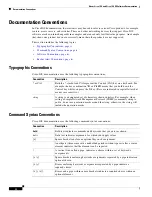
Using the Command-Line Interface in Cisco IOS and Cisco IOS XE Software
Using the CLI
viii
Understanding Enable and Enable Secret Passwords
Some privileged EXEC commands are used for actions that impact the system, and it is recommended
that you set a password for these commands to prevent unauthorized use. Two types of passwords, enable
(not encrypted) and enable secret (encrypted), can be set. The following commands set these passwords
and are issued in global configuration mode:
•
enable
password
•
enable secret
password
Using an enable secret password is recommended because it is encrypted and more secure than the
enable password. When you use an enable secret password, text is encrypted (unreadable) before it is
written to the config.text file. When you use an enable password, the text is written as entered (readable)
to the config.text file.
Each type of password is case sensitive, can contain from 1 to 25 uppercase and lowercase alphanumeric
characters, and can start with a number. Spaces are also valid password characters; for example,
“two words” is a valid password. Leading spaces are ignored, but trailing spaces are recognized.
Note
Both password commands have numeric keywords that are single integer values. If you choose a number
for the first character of your password followed by a space, the system will read the number as if it were
the numeric keyword and not as part of your password.
When both passwords are set, the enable secret password takes precedence over the enable password.
To remove a password, use the
no
form of the commands:
no enable
password
or
no enable secret
password
.
For more information about password recovery procedures for Cisco products, see
http://www.cisco.com/en/US/products/sw/iosswrel/ps1831/
products_tech_note09186a00801746e6.shtml
.
Using the Command History Feature
The CLI command history feature saves the commands you enter during a session in a command history
buffer. The default number of commands saved is 10, but the number is configurable within the range of
0 to 256. This command history feature is particularly useful for recalling long or complex commands.
To change the number of commands saved in the history buffer for a terminal session, issue the
terminal history
size
command:
Router#
terminal history
size
num
A command history buffer is also available in line configuration mode with the same default and
configuration options. To set the command history buffer size for a terminal session in line configuration
mode, issue the
history
command:
Router(config-line)#
history
[
size
num
]
To recall commands from the history buffer, use the following methods:
•
Press Ctrl-P or the up arrow key—Recalls commands beginning with the most recent command.
Repeat the key sequence to recall successively older commands.

























